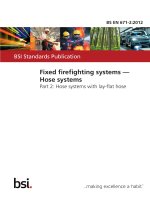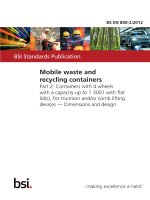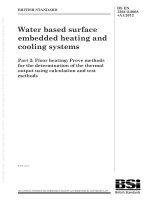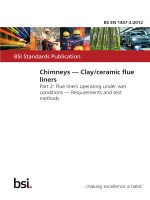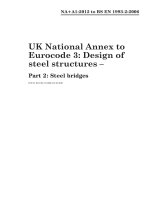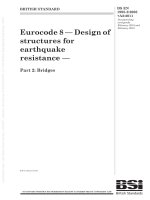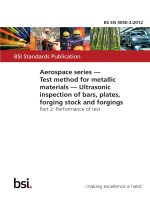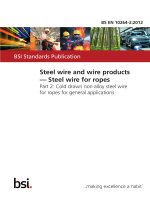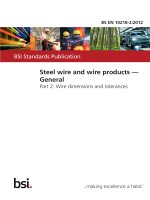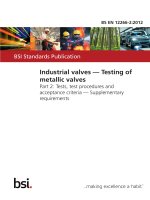Bsi bs en 62282 2 2012
Bạn đang xem bản rút gọn của tài liệu. Xem và tải ngay bản đầy đủ của tài liệu tại đây (1.27 MB, 46 trang )
BS EN 62282-2:2012
BSI Standards Publication
Fuel cell technologies
Part 2: Fuel cell modules
BRITISH STANDARD
BS EN 62282-2:2012
National foreword
This British Standard is the UK implementation of EN 62282-2:2012. It is
identical to IEC 62282-2:2012. It supersedes BS EN 62282-2:2004 which is
withdrawn.
The UK participation in its preparation was entrusted to Technical Committee
GEL/105, Fuel cell technologies.
A list of organizations represented on this committee can be obtained on
request to its secretary.
This publication does not purport to include all the necessary provisions of a
contract. Users are responsible for its correct application.
© The British Standards Institution 2012
Published by BSI Standards Limited 2012
ISBN 978 0 580 74607 9
ICS 27.070
Compliance with a British Standard cannot confer immunity from
legal obligations.
This British Standard was published under the authority of the Standards
Policy and Strategy Committee on 31 August 2012.
Amendments issued since publication
Amd. No.
Date
Text affected
BS EN 62282-2:2012
EUROPEAN STANDARD
EN 62282-2
NORME EUROPÉENNE
August 2012
EUROPÄISCHE NORM
ICS 27.070
Supersedes EN 62282-2:2004 + A1:2007
English version
Fuel cell technologies Part 2: Fuel cell modules
(IEC 62282-2:2012)
Technologies des piles à combustible Partie 2: Modules à piles à combustible
(CEI 62282-2:2012)
Brennstoffzellentechnologien Teil 2: Brennstoffzellenmodule
(IEC 62282-2:2012)
This European Standard was approved by CENELEC on 2012-04-30. CENELEC members are bound to comply
with the CEN/CENELEC Internal Regulations which stipulate the conditions for giving this European Standard
the status of a national standard without any alteration.
Up-to-date lists and bibliographical references concerning such national standards may be obtained on
application to the CEN-CENELEC Management Centre or to any CENELEC member.
This European Standard exists in three official versions (English, French, German). A version in any other
language made by translation under the responsibility of a CENELEC member into its own language and notified
to the CEN-CENELEC Management Centre has the same status as the official versions.
CENELEC members are the national electrotechnical committees of Austria, Belgium, Bulgaria, Croatia, Cyprus,
the Czech Republic, Denmark, Estonia, Finland, Former Yugoslav Republic of Macedonia, France, Germany,
Greece, Hungary, Iceland, Ireland, Italy, Latvia, Lithuania, Luxembourg, Malta, the Netherlands, Norway, Poland,
Portugal, Romania, Slovakia, Slovenia, Spain, Sweden, Switzerland, Turkey and the United Kingdom.
CENELEC
European Committee for Electrotechnical Standardization
Comité Européen de Normalisation Electrotechnique
Europäisches Komitee für Elektrotechnische Normung
Management Centre: Avenue Marnix 17, B - 1000 Brussels
© 2012 CENELEC -
All rights of exploitation in any form and by any means reserved worldwide for CENELEC members.
Ref. No. EN 62282-2:2012 E
BS EN 62282-2:2012
EN 62282-2:2012
-2-
Foreword
The text of document 105/378/FDIS, future edition 2 of IEC 62282-2, prepared by IEC/TC 105 "Fuel
cell technologies" was submitted to the IEC-CENELEC parallel vote and approved by CENELEC as
EN 62282-2:2012.
The following dates are fixed:
•
latest date by which the document has
to be implemented at national level by
publication of an identical national
standard or by endorsement
(dop)
2013-02-10
•
latest date by which the national
standards conflicting with the
document have to be withdrawn
(dow)
2015-04-30
This document supersedes EN 62282-2:2004 + A1:2007.
EN 62282-2:2012
EN 62282-2:2004:
includes
the
following
significant
technical
changes
with
respect
to
-
inclusion of definitions for hazards and hazardous locations based on the EN 60079 series;
-
the general safety strategy is modified to reflect the needs for different application standards. The
modifications are in line with similar modifications made to EN 62282-3-100;
-
the electrical components clause is modified to reflect the needs for different application standards.
The modifications are in line with similar modifications made to EN 62282-3-100;
-
the marking and instructions have been enlarged to provide the system integrator with the
necessary information.
Attention is drawn to the possibility that some of the elements of this document may be the subject of
patent rights. CENELEC [and/or CEN] shall not be held responsible for identifying any or all such
patent rights.
Endorsement notice
The text of the International Standard IEC 62282-2:2012 was approved by CENELEC as a European
Standard without any modification.
In the official version, for Bibliography, the following notes have to be added for the standards indicated:
IEC 60812
NOTE
Harmonised as EN 60812.
IEC 61025
NOTE
Harmonised as EN 61025.
IEC 60079-20-1
NOTE
Harmonised as EN 60079-20-1.
IEC 62282-3-100
NOTE
Harmonised as EN 62282-3-100.
ISO 1307:2006
NOTE
Harmonised as EN ISO 1307:2006 (not modified).
ISO 1402:2009
NOTE
Harmonised as EN ISO 1402:2009 (not modified).
BS EN 62282-2:2012
EN 62282-2:2012
-3-
Annex ZA
(normative)
Normative references to international publications
with their corresponding European publications
The following documents, in whole or in part, are normatively referenced in this document and are
indispensable for its application. For dated references, only the edition cited applies. For undated
references, the latest edition of the referenced document (including any amendments) applies.
NOTE When an international publication has been modified by common modifications, indicated by (mod), the relevant EN/HD
applies.
Publication
Year
IEC 60079
EN/HD
Year
Series Explosive atmospheres
EN 60079
Series
IEC 60079-10
Series Explosive atmospheres Part 10: Classification of areas
EN 60079-10
Series
IEC 60204-1
-
Safety of machinery - Electrical equipment of EN 60204-1
machines Part 1: General requirements
-
IEC 60335-1
-
Household and similar electrical appliances EN 60335-1
– Safety Part 1: General requirements
-
IEC 60352
Series Solderless connections
IEC 60512-15
Series Connectors for electronic equipment - Tests EN 60512-15
and measurements Part 15:Connector tests (mechanical)
Series
IEC 60512-16
Series Connectors for electronic equipment - Tests EN 60512-16
and measurements Part 16: Mechanical tests on contacts and
terminations
Series
IEC 60529
-
IEC 60617
Title
EN 60352
Series
Degrees of protection provided by
enclosures (IP Code)
EN 60529
-
Graphical symbols for diagrams
-
-
IEC 60695
Series Fire hazard testing
EN 60695
Series
IEC 60730-1
-
Automatic electrical controls for household
and similar use Part 1: General requirements
EN 60730-1
-
IEC 60950-1
-
Information technology equipment - Safety - EN 60950-1
Part 1: General requirements
-
IEC 61508
Series Functional safety of
EN 61508-1
electrical/electronic/programmable electronic
safety-related systems
IEC 62040-1
-
EN 62040-1
Uninterruptible Power Systems (UPS) Part 1: General and safety requirements for
UPS
IEC 62061
-
Safety of machinery - Functional safety of
safety-related electrical, electronic and
programmable electronic control systems
ISO 13849-1
-
Safety of machinery - Safety-related parts of EN ISO 13849-1
control systems Part 1: General principles for design
EN 62061
Series
-
-
-
BS EN 62282-2:2012
EN 62282-2:2012
-4-
Publication
Year
Title
EN/HD
Year
ISO 23550
-
Safety and control devices for gas burners
and gas-burning appliances - General
requirements
-
-
Electronic equipment for use in power
installations
EN 50178
-
–2–
BS EN 62282-2:2012
62282-2 © IEC:2012
CONTENTS
INTRODUCTION ..................................................................................................................... 6
1
Scope ............................................................................................................................... 7
2
Normative references ....................................................................................................... 8
3
Terms and definitions ....................................................................................................... 9
4
Requirements ................................................................................................................. 12
4.1
4.2
5
General safety strategy ......................................................................................... 12
Design requirements ............................................................................................. 14
4.2.1 General ..................................................................................................... 14
4.2.2 Behaviour at normal and abnormal operating conditions ............................ 14
4.2.3 Leakage .................................................................................................... 14
4.2.4 Pressurized operation ................................................................................ 14
4.2.5 Fire and ignition......................................................................................... 15
4.2.6 Safeguarding ............................................................................................. 16
4.2.7 Piping and fittings ...................................................................................... 16
4.2.8 Electrical components ............................................................................... 17
4.2.9 Terminals and electrical connections ......................................................... 17
4.2.10 Live parts .................................................................................................. 18
4.2.11 Insulating materials, dielectric strength ...................................................... 18
4.2.12 Bonding ..................................................................................................... 18
4.2.13 Shock and vibration ................................................................................... 18
Type tests ...................................................................................................................... 19
5.1
5.2
5.3
5.4
5.5
5.6
5.7
5.8
5.9
5.10
5.11
5.12
5.13
5.14
6
General ................................................................................................................. 19
Shock and vibration test ........................................................................................ 19
Gas leakage test ................................................................................................... 19
Normal operation ................................................................................................... 20
Allowable working pressure test ............................................................................ 21
Pressure withstanding test of cooling system ........................................................ 21
Continuous and short-time electrical rating ............................................................ 21
Overpressure test .................................................................................................. 21
Dielectric strength test ........................................................................................... 22
Differential pressure test ....................................................................................... 23
Gas leakage test (repeat) ...................................................................................... 24
Normal operation (repeat) ..................................................................................... 24
Flammable concentration test ................................................................................ 24
Tests of abnormal conditions ................................................................................. 24
5.14.1 General ..................................................................................................... 24
5.14.2 Fuel starvation test .................................................................................... 25
5.14.3 Oxygen/oxidant starvation test ................................................................... 25
5.14.4 Short-circuit test ........................................................................................ 25
5.14.5 Lack of cooling/impaired cooling test ......................................................... 25
5.14.6 Crossover monitoring system test .............................................................. 26
5.14.7 Freeze/thaw cycle tests ............................................................................. 26
Routine tests .................................................................................................................. 26
6.1
6.2
General ................................................................................................................. 26
Gas-tightness test ................................................................................................. 26
BS EN 62282-2:2012
62282-2 © IEC:2012
7
–3–
6.3 Dielectric strength withstand test ........................................................................... 27
Markings and instructions ............................................................................................... 27
7.1
7.2
7.3
7.4
Nameplate ............................................................................................................. 27
Marking ................................................................................................................. 27
Warning label ........................................................................................................ 27
Documentation ...................................................................................................... 27
7.4.1 General ..................................................................................................... 27
7.4.2 Installation manual .................................................................................... 29
7.4.3 Installation diagram ................................................................................... 29
7.4.4 Operation manual ...................................................................................... 30
7.4.5 Maintenance manual ................................................................................. 30
7.4.6 Parts list .................................................................................................... 30
Annex A (informative) Additional information for the performance and evaluation of the
tests ..................................................................................................................................... 32
Annex B (informative) List of notes concerning particular conditions in certain
countries ............................................................................................................................... 38
Bibliography .......................................................................................................................... 39
Figure 1 – Fuel cell system components and scope of standard .............................................. 8
Table 1 – Dielectric strength test voltages (derived from EN 50178) ..................................... 23
Table A.1 – Viscosity of gases at one atmosphere ................................................................ 35
–6–
BS EN 62282-2:2012
62282-2 © IEC:2012
INTRODUCTION
Fuel cell modules are electrochemical devices which convert continuously supplied fuel, such
as hydrogen or hydrogen rich gases, alcohols, hydrocarbons and oxidants to d.c. power, heat,
water and other by-products.
Fuel cell modules are sub-assemblies that are integrated into end-use products incorporating
one or more fuel cell stacks and, if applicable, additional components.
BS EN 62282-2:2012
62282-2 © IEC:2012
–7–
FUEL CELL TECHNOLOGIES –
Part 2: Fuel cell modules
1
Scope
This part of IEC 62282 provides the minimum requirements for safety and performance of fuel
cell modules and applies to fuel cell modules with the following electrolyte chemistry:
–
alkaline;
–
polymer electrolyte (including direct methanol fuel cells) 1;
–
phosphoric acid;
–
molten carbonate;
–
solid oxide;
–
aqueous solution of salts.
Fuel cell modules can be provided with or without an enclosure and can be operated at
significant pressurization levels or close to ambient pressure.
This standard deals with conditions that can yield hazards to persons and cause damage
outside the fuel cell modules. Protection against damage inside the fuel cell modules is not
addressed in this standard, provided it does not lead to hazards outside the module.
These requirements may be superseded by other standards for equipment containing fuel cell
modules as required for particular applications.
This standard does not cover road vehicle applications.
This standard is not intended to limit or inhibit technological advancement. An appliance
employing materials or having forms of construction differing from those detailed in the
requirements of this standard may be examined and tested according to the purpose of these
requirements and, if found to be substantially equivalent, may be considered to comply with
this standard.
The fuel cell modules are components of final products. These products require evaluation to
appropriate end-product safety requirements.
———————
1
Also known as proton exchange membrane fuel cell.
BS EN 62282-2:2012
62282-2 © IEC:2012
–8–
Fuel cell power system
Scope
System boundary
Power inputs
Electrical
Thermal
Mechanical
Thermal
management
system
Useable heat
Waste heat
Fuel
processing
system
Fuel
Oxidant
processing
system
Oxidant
Ventilation
Inert gas
Water
Ventilation
system
Fuel
cell
module
Power
conditioning
system
Water
treatment
system
Internal power
needs
Automatic
control
system
Energy to
elec./mech.
conversion
system
EMD
vibration,
wind, rain,
temperature
etc.
Useable power
electrical
mechanical
Condensate
Exhaust gases
EMI
noise
vibration
IEC 331/12
Key
EMD
EMI
electromagnetic disturbance
electromagnetic interference
Figure 1 – Fuel cell system components
This standard covers only up to the d.c. output of the fuel cell module.
This standard does not apply to peripheral devices as illustrated in Figure 1.
This standard does not cover the storage and delivery of fuel and oxidant to the fuel cell
module.
2
Normative references
The following documents, in whole or in part, are normatively referenced in this document and
are indispensable for its application. For dated references, only the edition cited applies. For
undated references, the latest edition of the referenced document (including any
amendments) applies.
IEC 60079 (all parts), Explosive atmospheres
IEC 60079-10 (all Parts 10), Explosive atmospheres − Part 10: Classification of areas
IEC 60204-1, Safety of machinery – Electrical equipment of machines – Part 1: General
requirements
IEC 60335-1, Household and similar electrical appliances – Safety – Part 1: General
requirements
IEC 60352 (all parts), Solderless connections
IEC 60512-15 (all parts), Connectors for electronic equipment – Tests and measurements –
Part 15: Connector tests (mechanical)
BS EN 62282-2:2012
62282-2 © IEC:2012
–9–
IEC 60512-16 (all parts) Connectors for electronic equipment – Tests and measurements –
Part 16: Mechanical tests on contacts and terminations
IEC 60529, Degrees of protection provided by enclosures (IP Code)
IEC 60617, Graphical symbols for diagrams
IEC 60695 (all parts), Fire hazard testing
IEC 60730-1, Automatic electrical controls for household and similar use – Part 1: General
requirements
IEC 60950-1, Information technology equipment – Safety – Part 1: General requirements
IEC 61508 (all parts), Functional safety of electrical/electronic/programmable electronic
safety-related systems
IEC 62040-1, Uninterruptible power systems (UPS) – Part 1: General and safety requirements
for UPS
IEC 62061, Safety of machinery – Functional safety of safety-related electrical, electronic and
programmable electronic control systems
ISO 13849-1, Safety of machinery – Safety related parts of control systems – Part 1: General
principles for design
ISO 23550, Safety and control devices for gas burners and gas-burning appliances – General
requirements
EN 50178, Electronic equipment for use in power installations
3
Terms and definitions
For the purposes of this document, the following terms and definitions apply.
3.1
acceptance test
contractual test to prove to the customer that the item meets certain conditions of its
specification
[SOURCE: IEC 60050-151:2001, 151-16-23] [1] 2
3.2
allowable differential working pressure
maximum pressure difference between the anode and cathode side specified by the
manufacturer which the fuel cell module can withstand without any damage or permanent loss
of functional properties
———————
2
References in square brackets refer to the bibliography.
– 10 –
BS EN 62282-2:2012
62282-2 © IEC:2012
3.3
allowable working pressure
maximum gauge pressure specified by the manufacturer which the fuel cell module can
withstand without any damage or permanent loss of functional properties
Note 1 to entry: For fuel cell modules incorporating pressure relief devices, this is normally used to define the
threshold of the set pressure.
3.4
ambient temperature
temperature of the medium surrounding a device, equipment or installation which may affect
the performance of the device, equipment or installation
3.5
conditioning
(related to cells/stacks) preliminary step that is required to properly operate a fuel cell module
(3.8) and that is realized following a protocol specified by the manufacturer
Note 1 to entry:
technology.
The conditioning may include reversible and/or irreversible processes depending on the cell
3.6
fuel cell
electrochemical device that converts the chemical energy of a fuel and an oxidant to electrical
energy (DC power), heat and reaction products
Note 1 to entry: The fuel and oxidant are typically stored outside the fuel cell and transferred into the fuel cell as
they are consumed.
3.7
fuel cell stack
assembly of cells, separators, cooling plates, manifolds and a supporting structure that
electrochemically converts, typically, hydrogen rich gas and air reactants to DC power, heat
and other reaction products
[SOURCE: IEC 62282-1:2010, 3.50] [2]
3.8
fuel cell module
assembly incorporating one or more fuel cell stacks and other main and, if applicable,
additional components, which is intended to be integrated into a power system
Note 1 to entry: A fuel cell module is comprised of the following main components: one or more fuel cell stack(s),
piping system for conveying fuels, oxidants and exhausts, electrical connections for the power delivered by the
stack(s) and means for monitoring and/or control. Additionally, a fuel cell module may comprise: means for
conveying additional fluids (e.g. cooling media, inert gas), means for detecting normal and/or abnormal operating
conditions, enclosures or pressure vessels and module ventilation systems.
3.9
rated current
maximum continuous electric current as specified by the fuel cell module manufacturer at
which the fuel cell module has been designed to operate
3.10
crossover
cross leakage
leakage between the fuel side and the oxidant side, of a fuel cell, in either direction, generally
through the electrolyte
3.11
gas leakage
sum of all gases leaving the fuel cell module except the intended exhaust gases
BS EN 62282-2:2012
62282-2 © IEC:2012
– 11 –
Note 1 to entry: Gas leakage may occur from
–
the fuel cell stack;
–
associated pressure relief devices;
–
other gas ducting and flow controlling components.
3.12
hazard
potential source of harm in the form of physical injury to the health of people, property or the
environment
3.13
hazardous area
classified area
area or space where combustible dust, ignitable fibres, or flammable, volatile liquids, gases,
vapours or mixtures are or may be present in the air in quantities sufficient to produce
explosive or ignitable mixtures
3.14
heat deflection temperature
temperature at which a standard test bar deflects a specified distance under load
Note 1 to entry:
It is used to determine short-term heat resistance.
3.15
lower flammability limit
LFL
minimum concentration of fuel in a fuel-air mixture where a combustion can be ignited by an
ignition source
Note 1 to entry: A fuel-air mixture is flammable when combustion can be started by an ignition source. The main
component is the proportions or composition of the fuel-air mixture. A mixture that has less than a critical amount
of fuel, known as the lower flammability limit (LFL) or more than a critical amount of fuel, known as the rich or
upper flammability limit (UFL), will not be flammable.
3.16
maximum operating pressure
maximum pressure, specified by the manufacturer of a component or system, at which it is
designed to operate continuously
Note 1 to entry: The maximum operating pressure is expressed in Pa.
Note 2 to entry: Includes all normal operation, both steady state and transient.
3.17
minimum voltage
lowest voltage that a fuel cell module is able to produce continuously at its rated power or
during its maximum permissible overload conditions, whichever voltage is lower
Note 1 to entry: The minimum voltage is expressed in V.
3.18
natural ventilation
movement of air and its replacement with fresh air due to the effects of wind and/or
temperature gradients
3.19
open-circuit voltage
voltage across the terminals of a fuel cell with fuel and oxidant present and in the absence of
external current flow
Note 1 to entry: The open-circuit voltage is expressed in V.
– 12 –
BS EN 62282-2:2012
62282-2 © IEC:2012
3.20
routine test
conformity test made on each individual item during or after manufacture
[SOURCE: IEC 60050-151:2001, 151-16-17]
Note 1 to entry: Not to be confused with “Conformity test” [IEC 60050-151:2001, 151-16-15]: test for conformity
evaluation or “Conformity evaluation” [IEC 60050-151:2001, 151-16-14]: systematic examination of the extent to
which a product, process or service fulfils specified requirements.
3.21
standard conditions
test or operating conditions that have been predetermined to be the basis of the test in order
to have reproducible, comparable sets of test data
3.22
safeguarding
control system actions, based on process parameters, taken to avoid conditions that might be
hazardous to personnel or might result in damage to the fuel cell or its surroundings
3.23
safety extra low voltage
SELV
voltage under normal and single fault conditions that do not exceed 30 V r.m.s. or 42,4 V
peak/d.c. in dry environments or when wet contact is likely to occur, 15 V r.m.s. or 21,2 V
peak/d.c.
3.24
thermal equilibrium conditions
stable temperature conditions indicated by temperature changes of no more than 3 K (5 °F) or
1 % of the absolute operating temperature, whichever is higher between two readings 15 min
apart
3.25
thermal stability
stable temperature isothermal conditions
3.26
type test
conformity test made on one or more items representative of the production
[SOURCE: IEC 60050-151:2001, 151-16-16]
Note 1 to entry: Not be confused with “Conformity test” [IEC 60050-151:2001, 151-16-15]: test for conformity
evaluation or “Conformity evaluation” [IEC 60050-151:2001, 151-16-14]: systematic examination of the extent to
which a product, process or service fulfils specified requirements.
4
4.1
Requirements
General safety strategy
The manufacturer shall perform in written form a risk analysis to ensure that
a) all reasonably foreseeable hazards, hazardous situations and events throughout the
anticipated fuel cell power system’s lifetime have been identified (see Annex A for a listing
of typical hazards),
b) the risk for each of these hazards has been estimated from the combination of probability
of occurrence of the hazard and of its foreseeable severity,
BS EN 62282-2:2012
62282-2 © IEC:2012
– 13 –
c) the two factors which determine each one of the estimated risks (probability and severity)
have been eliminated or reduced to a level not exceeding the acceptable risk level, as far
as is practically possible, through
1) inherently safe design of the construction and its methods, or
2) passive control of energy releases without endangering the surrounding environment
(for example, burst disks, release valves, thermal cut-off devices) or by safety related
control functions, and
3) for residual risks which could not have been reduced by the measures according to 1)
and 2), provision of labels, warnings or requirements of special training shall be given,
considering that such measures need to be understood by the persons which are in
the area of the hazards.
For functional safety, the required severity level, performance level or the class of control
function shall be determined and designed in accordance with e.g.:
•
IEC 62061 (respectively ISO 13849-1) for applications according to IEC 60204-1;
•
IEC 60730-1 for appliances according to IEC 60335-1;
•
IEC 61508 (all parts) for other applications.
For failure mode and effects analysis (FMEA) and fault tree analysis methods, the following
standards can be used as guidance:
•
IEC 60812 [3];
•
SAE J1739 [4];
•
IEC 61025 [5].
The assessment shall also cover the following possible risks:
−
stack temperature, and
−
stack and/or cell voltage,
−
pressure of pressurized parts.
Furthermore, care shall be taken to address the following:
–
mechanical hazards – sharp surfaces, tripping hazards, moving masses and instability,
strength of materials, and liquids or gases under pressure;
–
electrical hazards – contact of persons with live parts, short-circuits, high voltage;
–
EMC hazards – malfunctions of the fuel cell module when exposed to electromagnetic
phenomena or malfunctions of other (nearby) equipment due to electromagnetic emissions
from the fuel cell module;
–
thermal hazards – hot surfaces, release of high temperature liquids or gases, thermal
fatigue;
–
fire and explosion hazards – flammable gases or liquids, potential for explosive mixtures
during normal or abnormal operating conditions, potential for explosive mixtures during
faulted conditions;
–
malfunction hazards – unsafe operation due to failures of software, control circuit or
protective/safety components or incorrect manufacturing or misoperation;
–
material and substance hazards – material deterioration, corrosion, embrittlement, toxic
releases;
–
waste disposal hazards – disposal of toxic materials, recycling, disposal of flammable
liquids or gases;
–
environmental hazards – unsafe operation in hot/cold environments, rain, flooding, wind,
earthquake, external fire, smoke.
– 14 –
4.2
4.2.1
BS EN 62282-2:2012
62282-2 © IEC:2012
Design requirements
General
The fuel cell module shall be designed in accordance with a risk assessment performed by
the fuel cell module manufacturer. All parts shall be
a) suitable for the range of temperatures, pressures, flow rates, voltages and currents to
which they are subjected during intended usage, and
b) resistant to the reactions, processes and other conditions to which they are exposed
during intended usage.
c) The quality and thickness of the materials used in the fuel cell module, their fitting
elements and terminals and the method of assembling the various parts, shall be such that
the constructional and operational characteristics are not significantly altered during a
reasonable lifetime and under normal conditions of installation and use. All parts of the
fuel cell module shall withstand the mechanical, chemical and thermal conditions to which
they may be subjected when the end user product is used normally.
Fuel cell module enclosures shall comply with the requirements given by IEC 60529 to fit into
the application system. The fuel cell module shall carry the IP-Code accordingly.
NOTE An IP00 rating indicating non-protected may be appropriate when the end use equipment has a protective
enclosure.
4.2.2
Behaviour at normal and abnormal operating conditions
The fuel cell module shall be designed in such a way that it withstands all normal operating
conditions as defined by the manufacturer’s specification without any damage. Abnormal
operating conditions shall be covered according to 4.1.
4.2.3
Leakage
Depending on the design, leakage of combustible gases or liquids may occur (test see 5.3).
The gas leakage rate shall be included in the specification document, so that the integrator of
the fuel cell system can determine the minimum capacity of the required ventilation system
(see 7.4.1, r), purging and ventilation flow rate requirements.
The fault mode "crossover" shall be part of the risk assessment according to 4.1. Measures
e. g. "cell voltage monitors" shall be designed according to the relevant standard given in 4.1.
When crossover protection is not included in the fuel cell module, the product documentation
shall describe any protective devices or operating procedures that have to be provided by the
system integrator.
NOTE
4.2.4
For classification of hazardous areas, consider IEC 60079-10.
Pressurized operation
If fuel cell modules include gas-tight and pressurized enclosures, those enclosures shall
comply with national regulations.
Pressure operation conditions that could generate hazardous conditions outside of the module
shall be identified (see 4.1) and the information conveyed to the system integrator
NOTE
The following modules present particular properties:
PEFC modules
Pressure is not a significant design factor for the design of a PEFC (polymer electrolyte fuel cell stack). The
dimensioning, choice of material and manufacturing rules of a PEFC stack are based primarily on requirements for
sufficient strength, rigidity and stability to meet the static, dynamic, and/or other operational characteristics. For
example, a design using coaxial force compression hardware leaks before it breaks.
BS EN 62282-2:2012
62282-2 © IEC:2012
– 15 –
PAFC modules
The PAFC (phosphoric acid fuel cell) module usually operates under atmospheric pressure.
MCFC modules
For a pressurized operation of a MCFC (molten carbonate fuel cell), the MCFC module is integrated into an MCFC
system. This MCFC system provides the housing of the MCFC module and is designed according to the applicable
national and international codes and standards for pressurized systems.
A hazard due to pressure associated with an MCFC module can be excluded due to the housing, which is in
accordance with the regulations mentioned.
SOFC modules
If pressurized operation of a SOFC (solid oxide fuel cell) is foreseen, the SOFC module is integrated into the SOFC
power system. For that application, the SOFC module is enclosed within a pressure vessel designed, manufactured
and equipped according to applicable national and international codes and standards for pressurized systems.
4.2.5
4.2.5.1
Fire and ignition
General
The fuel cell module shall be protected by means (for example, ventilation, gas detectors,
controlled oxidation, operating temperatures higher than the auto-ignition temperature, etc.)
such that leaking gases from, or inside, the fuel cell module cannot form explosive
concentrations.
The design criteria for such means (for example required ventilation rate) shall be provided by
the fuel cell module manufacturer. The means shall be provided either by the fuel cell module
manufacturer or by the fuel cell system manufacturer. If the fuel cell manufacturer does not
provided such means, then he shall provide the design and test criteria for such means (for
example required ventilation rate).
Components and materials inside the classified gas flammable atmospheres shall be
constructed or shall make use of such materials that propagation of fire and ignition is
mitigated. The material flammability shall be such that a sustained fire will not be supported
after electrical power and the fuel and oxidant supply have been terminated. This may be
demonstrated through the selection of materials meeting V 0, V 1 or V 2 in accordance with
the IEC 60695 series.
NOTE The auto-ignition temperatures commonly listed in standards such as IEC 60079-20-1[6] are the minimum
temperatures at which a flammable gas mixture may ignite. The actual auto-ignition temperatures can be well
above these values depending on the surface geometry, material and the actual gas mixtures. This requirement
refers to an auto-ignition temperature that will ignite a flammable gas under all conditions for the chosen materials
and geometry.
The requirements of the application standard as given in 4.1 shall be considered concerning
"Resistance to heat and fire".
4.2.5.2
Exemptions
Membranes, or other materials within the fuel cell stack volume which comprise less than
10 % of the total fuel cell module mass, are considered to be of limited quantity and are
permissible without flame spread ratings. If such material is used, this should be part of the
product specification so that the system integrator can take care on it.
If the actual temperature in any location of the fuel cell module, where a flammable mixture
may occur, is higher than the auto-ignition temperature, leakage of fuel gas into the oxidant or
vice versa results in immediate oxidation of the flammable gas. Thus, it is obvious that no
major concentrations of explosive gases can accumulate.
Whenever this temperature of such high-temperature fuel cells is lower than the auto-ignition
temperature, the fuel cell module shall be transferred into a safe state (for example, by
purging).
– 16 –
4.2.6
BS EN 62282-2:2012
62282-2 © IEC:2012
Safeguarding
The failure of a component within a safety control system (see 4.1 c) shall cause the fuel cell
module to initiate a controlled shut-down. To ensure the required level of safeguarding (SILLevel, performance level or class of control function) the safety relevant design shall comply
with the relevant standards given in 4.1.
NOTE The controlled shut-down may include a time delay, or allow for the completion of an operational cycle,
when immediate shut-down would result in a higher risk. An example may be the failure of a gas detector in a fuel
cell module used as an emergency power supply.
4.2.7
4.2.7.1
Piping and fittings
General
Threaded connections of combustible gases conveying piping and fittings shall comply with
ISO 23550. All other joints shall be welded, or at least have fitting connections with a defined
sealing area as specified by the manufacturer. Unions, when used in fuel gas or oxygen lines,
shall be of the ground-joint type or the flanged-joint type or the compression-joint type having
packing resistant to the action of fuel gases.
The internal surfaces of piping shall be thoroughly cleaned to remove loose particles and the
ends of piping shall be carefully reamed to remove obstructions and burrs.
Flexible piping and associated fittings, when used for conveying gas, shall be suitable for the
application. Special consideration shall be given to hydrogen pipes, such as aging behaviour,
embrittlement, porosity, etc.
NOTE Information on compliance with various requirements can be found in the following standards: ISO 37,
ISO 188, ISO 1307, ISO 1402, ISO 1436 and ISO 4672 [7] to [12].
4.2.7.2
Non-metallic piping systems
Polymeric and elastomeric piping, tubing and components shall be permitted under the
following conditions.
Materials shall be demonstrated to be suitable over lifetime for the combined maximum
operating temperatures and pressures and compatible with other materials and chemicals
they will come in contact within service and during maintenance. Adequate mechanical
strength shall be demonstrated according to 5.4 and 5.5.
Plastic or elastomeric components shall be protected from mechanical damage within the fuel
cell module. Shielding may be used as appropriate to protect components against failure of
rotating equipment or other mechanical devices housed within the unit.
Any compartment enclosing plastic or elastomeric components used to convey flammable
gases shall be protected against the possibility of overheating.
If danger of fuel flow temperature more than 10 K below the lowest heat deflection
temperature cannot be excluded a control system complying with the requirements according
the relevant standard as given in 4.1 to cover the allocated risk shall be provided to terminate
the fuel flow.
Plastic or elastomeric materials used in a hazardous location shall be electrically conductive
or otherwise designed to avoid static charge build-up, e. g. by limitation of flow rate or other.
Plastic or elastomeric materials with insufficient electrical conductivity shall only be used in
non-hazardous areas.
BS EN 62282-2:2012
62282-2 © IEC:2012
4.2.7.3
– 17 –
Metallic piping systems
Metallic piping systems shall be suitable for the combined maximum operating temperatures
and pressures and shall be compatible with other materials and chemicals they will come in
contact within service and during maintenance. Metallic piping systems shall be of sufficient
mechanical integrity. Adequate mechanical strength shall be demonstrated according to 5.5
and 5.6.
Metallic piping systems shall be compliant with the leakage requirement according to 5.3.
Formed piping bends shall not promote failure caused by the forming process and shall
comply with the following:
–
bends shall be made only with bending equipment and procedures intended for that
purpose;
–
all bends shall be smooth and free from buckling, cracks, or other evidence of mechanical
damage;
–
the longitudinal weld of the pipe shall be near the neutral axis of the bend;
–
the inside radius of a bend shall be not less than the minimum radius specified by the pipe
manufacturer.
4.2.8
Electrical components
The electric system design and construction, as well as the application of the electric and
electronic equipment, including electric motors and enclosures, shall meet the requirements of
relevant electrical product application standard(s). For example:
•
IEC 60335-1 (e.g. residential/commercial and light industrial);
•
IEC 60204-1 (e.g. large industrial);
•
IEC 60950-1 (e.g. telecom);
•
IEC 62040-1 (e.g. UPS).
The selection of the appropriate application will be provided in the technical specification.
The fuel cell designer shall also consider the following fuel cell specific issues:
•
residual charge on the fuel cell stack;
•
energy hazard between cells.
The suitability of the electrical components for the ambient conditions specified for the
operation of the fuel cell system shall be communicated to the fuel cell system integrator (see
7.4.1, i): range of ambient temperature and humidity for operation and storage.
If the electric components are provided by the system integrator, he shall be informed about
the necessary technical specification so that safety can be ensured.
Where an enclosed fuel cell module, operating below the auto-ignition temperature of the
combustible gas, does not comply with the flammable concentration limits described in 5.12,
the electrical components located within the enclosure shall be suitable for the area
classification as defined in IEC 60079-10, using a protection technique defined within the
IEC 60079 series.
4.2.9
Terminals and electrical connections
Power connections to external circuitry shall be
a) fixed to their mountings with no possibility of self-loosing,
– 18 –
BS EN 62282-2:2012
62282-2 © IEC:2012
b) constructed in such a way that the conductors cannot slip out from their intended location,
c) such that proper contact is assured without damage to the conductors that would impair
the ability of the conductors to fulfil their function, and
d) so secured against turning, twisting or permanently deforming during normal tightening
onto the conductor.
Connections made directly to the fuel cell shall not be appreciably impaired by conditions
occurring in normal service. Terminals of the fuel cell module shall comply with IEC 60352,
IEC 60512-15 (all parts) and IEC 60512-16 (all parts) or with the requirements as given for
terminals and electrical connections in the application standards according to 4.2.8.
4.2.10
Live parts
The manufacturer’s technical documentation shall specify according to the relevant
application standards as given in 4.2.8:
a) accessible live parts that do not meet the requirements for safety extra low voltage (SELV);
b) accessible live parts that present a high current hazard due to shorting.
The fuel cell system integrator shall be responsible for the protection of these live parts
against electric shock.
4.2.11
Insulating materials, dielectric strength
The design of all dielectrics of the fuel cell module, applied between live parts and non
current-carrying metal parts, shall be in accordance with applicable standards as given in
4.2.8 for electrical equipment of appropriate voltage class.
The mechanical characteristics of the materials that affect functional behaviour, for example
compressive strength, shall comply with the design criteria at a temperature up to at least
20 K or 5 % (whichever is higher) above the maximum temperature observed under normal
operation, but not less than 80 °C.
Verification shall be based on the properties and characteristics of the material as defined by
the manufacturer of the material.
4.2.12
Bonding
The following applies unless the relevant application standards as given in 4.2.8 are
specifying it differently
Accessible not current-carrying metal parts that are likely to become energized through
electrical fault, and that can lead to an electric shock, or an electrical energy hazard, shall be
bonded to a common point.
To ensure good electrical contact, these connections shall be protected against corrosion.
They shall also be designed so that the conductors are secured against loosening and
twisting and that contact pressure is maintained.
There shall be no electrochemical corrosion between metallic parts, which form a bonding
under the expected conditions of use, storage and transportation. Resistance against
electrochemical corrosion may be achieved through appropriate plating or coating processes.
4.2.13
Shock and vibration
The shock and vibration limits that the fuel cell module is designed to withstand shall be
included in the manufacturer’s documentation.
BS EN 62282-2:2012
62282-2 © IEC:2012
5
– 19 –
Type tests
5.1
General
Type tests shall be performed in a test facility simulating the anticipated fuel cell system or
the fuel cell system itself, in order to obtain the required operating conditions. In particular,
the test facility for performing the type tests of normal operation can be the conditioning
facility used for the initial start-up of the fuel cell module. It is recommended that the type
tests be performed in the order described below. The test of abnormal conditions may be
destructive.
5.2
Shock and vibration test
The fuel cell module shall be subject to the shock and vibration test limits stated in the
manufacturer’s documentation.
NOTE It may be that the manufacturer has not specified shock and vibration limits, in which case no tests are
required.
Compliance is given if the device under test withstands the manufacturer’s specified vibration
and shock criteria with no evidence of damage. The device under test operates as intended
after the conditioning.
5.3
Gas leakage test
This test is not applicable for fuel cell modules with
–
operating temperatures higher than the auto-ignition temperature of the combustible gas
(see 4.2.5), or
–
fuel cells within a gas-tight vessel already proven according to the relevant national
regulations.
Where it is impractical to use the full stack, a stack with a reduced, but still representative,
number of cells can be used. Leakage shall be calculated based on the ratio of cell numbers.
The fuel cell module shall be operated until it attains thermal equilibrium conditions at the
maximum operating temperature under full load current.
Once these conditions have been achieved, operation is ceased, the fuel cell module may be
purged and the gas outlets closed; the fuel cell module temperature shall be reduced to the
lowest specified operating temperature or below. The fuel cell module shall then be
pressurized, either with the nominal anode gas or helium, gradually to the maximum operating
pressure, defined by manufacturer, and held steady for 1 min.
The inlet pressure shall remain stable and unchanged during the time the leakage is
measured. The gas leakage rate shall be measured using a flow meter located at the inlet of
the fuel cell module, upstream of a pressure relief device and capable of measuring the
leakage rate with an accuracy of 2 %. If helium is used as test gas, the gas leakage rate shall
be corrected according to
where
R = fuel gas leakage rate/test gas leakage rate
(1)
R = (TGSG/FGSG) 1/2
(2)
and
TGSG
is the test gas specific gravity;
FGSG
is the fuel gas specific gravity;
or
R = µtest / µfuel
(3)
20
BS EN 62282-2:2012
62282-2 â IEC:2012
where
àtest
is the test gas absolute viscosity;
µfuel
is the fuel gas absolute viscosity.
These two formulas shall be used to calculate R and the worst-case scenario, i.e. the higher
value, shall be reported.
The rate of gas leakage, including the flow rate of gas through the pressure relief valve, shall
be recorded.
If the pressure relief device is not included in the test, because of, for example, hysteresis or
pressure setting, then the total leakage shall be the sum of the leakage of the pressure relief
device alone at maximum fuel supply pressure and that obtained from this test.
The gas leakage rate, corrected to reference conditions and gas type, multiplied by 1,5 shall
comply with the gas leakage rate included in the documentation (see 7.4).
NOTE It is anticipated that this information may need to be provided to the end-product user for the purpose of
calculating the ventilation needs.
5.4
Normal operation
Normal operation is the operation of the fuel cell module under normal conditions, in particular
–
nominal power output with respect to voltage and current;
–
nominal thermal energy output with respect to temperature and cooling media flow (if
applicable);
–
nominal temperature range of the fuel cell module;
–
nominal fuel composition;
–
nominal flows of anode and cathode media;
–
nominal pressure ranges of anode and cathode fluids;
–
rate of change of power output within the nominal ranges defined in the manufacturer’s
specification.
For the normal operation type test, the fuel cell module shall be operated under the normal
conditions defined above until thermal equilibrium conditions are achieved.
Measurements of the following parameters shall be taken and the results recorded in the
documentation as specified in 7.4:
a) voltage at the terminals of the fuel cell module at full load current;
b) temperatures (fuel cell stack, fuel cell module surface, ambient);
c) fuel pressure (gauge) from –5 % to +5 % or ± 1 kPa, whichever is the higher;
d) fuel consumption rate from –5 % to +5 %;
e) oxidant supply from –5 % to +5 %, if applicable;
f)
oxidant pressure from –5 % to +5 % or ± 1 kPa whichever is the higher, if applicable;
g) coolant inlet and outlet temperature (if applicable);
h) coolant flow rate (if applicable);
i)
coolant inlet and outlet pressure (if applicable);
j)
fuel and oxidant differential pressure.
Compliance is given if, for all parameters measured, the measured values are within the
manufacturer's specified values.
BS EN 62282-2:2012
62282-2 © IEC:2012
5.5
– 21 –
Allowable working pressure test
The fuel cell module shall be tested at the maximum or minimum operating temperature,
whichever is more severe.
During this test, the fuel and air sides of the fuel cell module may be interconnected if they
are of the same internal pressure under normal operation. If the fuel cell module comprises a
cooling system, this system may be over-pressure tested simultaneously and in the same way.
The fuel cell module (both anode and cathode channels) shall be pressurized gradually and
held steady for a period of not less than 1 min to no less than 1,3 times their allowable
working pressure.
If the fuel cell module comprises a pressure relief valve, it may be removed or made
inoperable.
This test may be conducted during the gas leakage test or the normal operating test, provided
that the test parameters can be achieved.
If the test conditions (temperature) cannot be achieved, the fuel cell module shall be tested at
ambient temperature at not less than 1,5 times the allowable working pressure.
There shall be no rupture, fracture, permanent deformation or other physical damage to the
fuel cell module.
5.6
Pressure withstanding test of cooling system
This test shall be performed if the cooling system is not tested during the allowable working
pressure test.
The fuel cell module shall be tested at the same temperature as in the allowable working
pressure test.
The cooling system of the fuel cell module shall be pressurized to 1,3 times the allowable
working pressure of the cooling system, and then maintained for a period of not less than
10 min.
If the test conditions (temperature) cannot be achieved, the cooling system shall be tested at
ambient temperature at 1,5 times the allowable working pressure of the cooling system.
There shall be no rupture, fracture, permanent deformation or other physical damage to the
system. If the system utilizes a liquid coolant, there shall be no leakage of coolant during this
test.
5.7
Continuous and short-time electrical rating
Where a manufacturer specifies a short-time current rating, the fuel cell module shall be
stabilized at rated current, then the current increased to the defined short-time rating and held
for the defined time, as specified by the manufacturer.
There shall be no rupture, fracture, permanent deformation or other physical damage to the
system.
5.8
Overpressure test
Where the fuel cell module has a pressure-limiting device, the pressure shall be increased
step by step to a value that exceeds the threshold pressure of the pressure-limiting device. If
necessary, the fuel cell module inlet pressure regulator shall be disabled or bypassed for this
– 22 –
BS EN 62282-2:2012
62282-2 © IEC:2012
test. The safety mechanism shall trigger a reduction in the pressure or transfer the fuel cell
module into a safe operational state.
In case of a leak before break design, this test may be destructive and may be performed
under 5.13. The data of this test shall be reported to the systems integrator as shall all
consequential hazards.
5.9
Dielectric strength test
Fuel cell modules can be manufactured according to two different designs:
a) stack grounded;
b) stack floating.
For design a), no dielectric withstand test can be applied, only the open-circuit voltage
appears.
For design b), the dielectric strength test shall be applied at operating temperature, and with
cooling media applied. If the fuel cell module cannot be maintained at operating temperature,
the dielectric strength test shall be carried out at the maximum admissible temperature and
the temperature shall be recorded. If the dielectric strength test is applicable, it shall be
performed on the fully assembled fuel cell module, disconnected from the fuel supply and
purged with purging gas. The test voltage shall be applied between live parts and non currentcarrying metal parts. The test shall be performed either with a DC or an AC voltage of
substantially sinusoidal waveform at a frequency between 48 Hz and 62 Hz. The voltage shall
be increased steadily to the specified value and then maintained for at least 5 s. The results
are acceptable if there is no breakdown of the insulation. The leakage current shall not
exceed 1 mA multiplied by the ratio of the test voltage to the open circuit voltage. If this value
cannot be met, the data of this test shall be provided to the systems integrator. All
consequential hazards shall be mitigated by the systems integrator.
NOTE
Dependent on the final application, a test duration over 5 s might be required.
The test voltages shall be as mentioned in Table 1.
